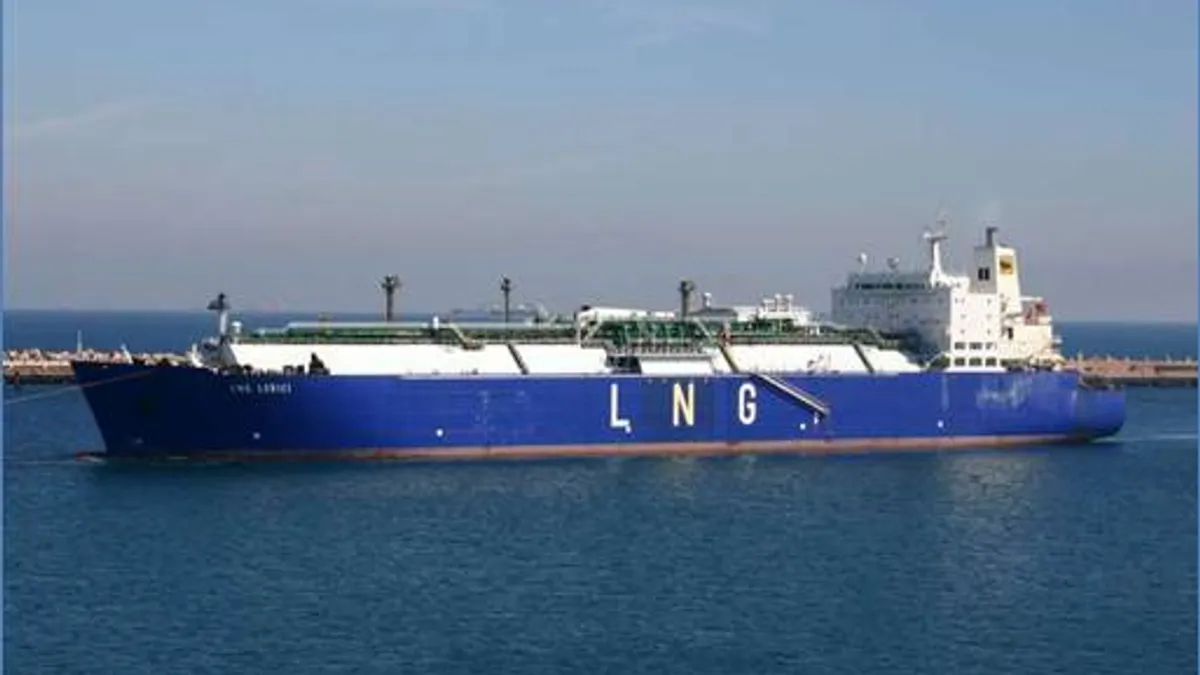Dive Brief:
- The Federal Energy Regulatory Commission (FERC) on Thursday approved a long-delayed liquefied natural gas (LNG) export facility after reaching a deal on how to calculate its climate change impacts that could pave the way for a dozen more approvals.
- FERC voted 3-1 to approve the Venture Global Calcasieu Pass LNG export facility in Louisiana, with Democrat Commissioner Rich Glick dissenting. Fellow Democrat Commissioner Cheryl LaFleur voted for the facility after the inclusion of greenhouse gas calculations in the approval order.
- The FERC majority and Department of Energy (DOE) hope the order can be used as a template to speed approval of 12 other export facilities pending at the commission. That would help the U.S. supply LNG to its global allies and could spur investment in more LNG facilities here and abroad, DOE Deputy Secretary Dan Broulliette told Utility Dive.
Dive Insight:
Approval of the Calcasieu Pass project represents a major compromise for FERC, which had not approved an LNG export facility in two years due to a shortage of staff manpower and a recent impasse between Republicans and Democrats on the commission.
FERC has been without its full contingent of five commissioners for most of the last two years due to confirmation delays, resignations and the death of Commissioner Kevin McIntyre in January. In recent months, that allowed the two Democrats to deadlock commission votes, blocking action on natural gas infrastructure.
LaFleur previously supported approval of LNG facilities when she was chair of FERC under the Obama administration, but recently has pushed for a fuller accounting of climate change impacts for both gas pipelines and export facilities. At FERC's December 2018 meeting, Chairman Neil Chatterjee removed a scheduled vote on the Calcasieu Pass facility at the last minute when it became clear LaFleur would not support it.
The inclusion of more climate change analysis in the final order appears to have broken the deadlock. Unlike previous LNG orders, the Calcasieu Pass decision includes estimates for the facility's direct greenhouse gas (GHG) emissions, calculating that it "could potentially increase CO2 emissions based on the 2016 levels by 0.07% at the national level."
For LNG facilities, DOE, and not FERC, weighs emission impacts to determine if an export terminal is in the public interest. Even so, LaFleur wrote in a concurrence that FERC "has the clear responsibility" to at least disclose the expected GHG pollution from a facility.
While the calculation did not affect the outcome of the decision, DOE Under Secretary of Energy Mark Menezes said it made the difference in FERC negotiations.
"For Cheryl LaFleur, [the order] shows that there were direct emissions with the facility, but she was able to put it in context based on the U.S. total emissions for 2016, and so to her that was a significant accomplishment," Menezes told Utility Dive Thursday night. "To the layperson it may not seem such a big deal, but it was enough to get her vote and it was enough for her."
LaFleur's office did not immediately respond to a request for comment, but her concurrence notes her appreciation that FERC disclosed the GHG emissions in the final order.
"I believe at a minimum direct GHG emissions must be disclosed and considered, both cumulatively and with respect to individual facilities," she wrote.
That GHG disclosure, however, is only a "first step" in determining how the FERC should weigh emissions against the potential benefits of a project, LaFleur argued. For that, she reiterated her recommendation to use the Social Cost of Carbon, a measurement developed by the Obama administration, to ascribe significance to GHG emissions.
That aspect was not included in FERC's final order approving Calcasieu Pass, however. Instead, the FERC majority reiterated its previous position that "it could not determine whether a project's contribution to climate change would be significant."
While that omission was not enough to inspire opposition for LaFleur, it was a dealbreaker for Glick, who has repeatedly argued that FERC's underlying statutes require it to assess the significance of climate change contributions.
"I cannot countenance an approach that acts as if climate change is not relevant to the public interest," he wrote in a dissent. "So long as the Commission adheres to such a deeply misguided approach, I have no choice but to dissent from its orders, regardless of what I might otherwise think about the benefits of a project."
Late Thursday, Chairman Chatterjee joined DOE officials in praising new Republican Commissioner Bernard McNamee for helping to reach a "breakthrough" compromise with LaFleur. McNamee was confirmed to FERC in December after a controversial nomination process.
"Commissioner McNamee showed just how he got his reputation as being a ‘lawyer's lawyer' through his attention to the law and work to find common ground," Chatterjee said in a statement. "And Commissioner LaFleur was supportive of this project and constructive in working to reach our agreement."
"Those that look for us for opportunities for increased LNG they will point to us, the bottleneck that we've had at FERC," Menezes said. "So they've constantly put us somewhat on the defensive about this because there wasn't anything that we could demonstrate that we've been able to do over at FERC to increase. the number of LNG export terminals. So this is a big day today."
If the compromise holds for some of the larger LNG export facilities on FERC's agenda, Brouillette said he expects more applications to construct new facilities in the future.
"People now have a roadmap for how to get these things approved," he said. "Commissioner LaFleur's vote today, the legal work done by Commissioner McNamee and Chairman Chatterjee, I think give certainty to the investment community. So if we can follow this construct for future applications I think you will see investors come into this by leaps and bounds."













